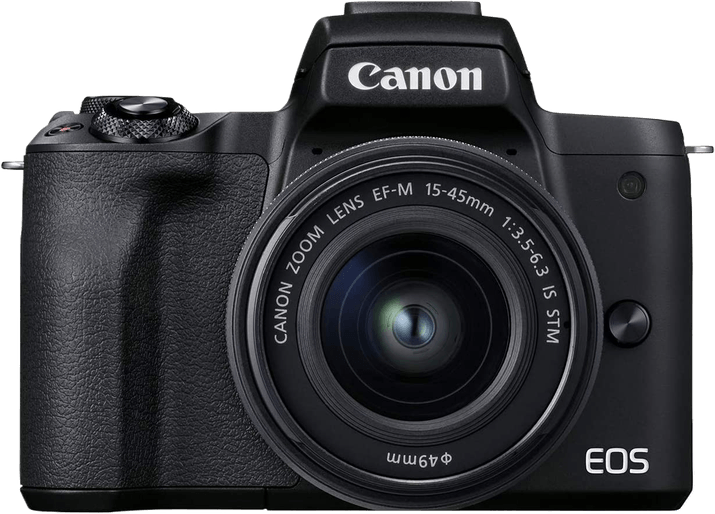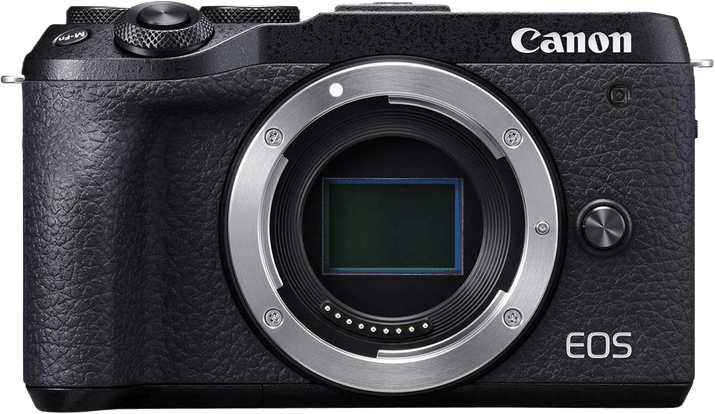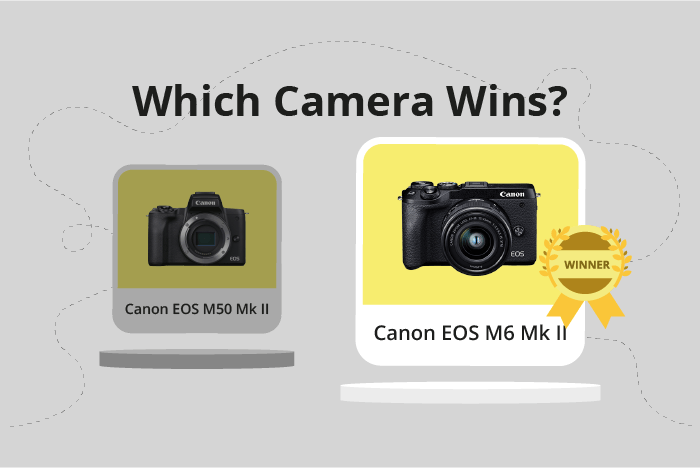Canon EOS M50 Mark II vs EOS M6 Mark II Comparison
Canon EOS M50 Mark II

Canon EOS M6 Mark II

The Canon EOS M6 Mark II outperforms the Canon EOS M50 Mark II with a score of 63/100 compared to 59/100. Both cameras are mirrorless, released in 2019 and 2020, respectively, and share similar dimensions and weight. The M6 Mark II is slightly heavier at 408g, while the M50 Mark II weighs 387g.
The M6 Mark II has an advantage due to its higher score, justifying its higher launch price of $850 compared to the M50 Mark II’s $750. The M50 Mark II, on the other hand, offers a more compact and lightweight design, making it more portable and user-friendly.
Taking these factors into account, the Canon EOS M6 Mark II emerges as the superior camera with its higher score and better performance, while the Canon EOS M50 Mark II offers a more budget-friendly and compact option for those prioritizing portability.
Canon EOS M50 Mark II vs EOS M6 Mark II Overview and Optics
The Canon EOS M6 Mark II edges out the Canon EOS M50 Mark II in optics with a score of 62/100 compared to the M50 Mark II’s 59/100. Both cameras share several specifications, including the CMOS sensor type, Digic 8 processor, DXOMARK score of 58 for the sensor, APS-C sensor size, Canon EF-M lens mount, and the lack of image stabilization.
The EOS M6 Mark II outperforms the M50 Mark II in two key areas: megapixels and shooting speed. The M6 Mark II has a 33-megapixel sensor, compared to the M50 Mark II’s 24-megapixel sensor. This difference allows the M6 Mark II to capture more detail and produce higher resolution images. Additionally, the M6 Mark II has a faster shooting speed of 14 frames per second, compared to the M50 Mark II’s 10 frames per second. This faster speed enables the M6 Mark II to better capture fast-moving subjects and action shots.
On the other hand, the M50 Mark II does not have any specific advantages over the M6 Mark II in optics. Both cameras have the same sensor type, processor, sensor size, lens mount, and lack of image stabilization. Therefore, the M50 Mark II does not excel in any particular area compared to the M6 Mark II.
Taking these factors into account, the Canon EOS M6 Mark II is the better choice for those prioritizing image quality and shooting speed. The higher megapixel count and faster shooting capabilities make it a more versatile option for capturing a wide range of subjects and situations. Meanwhile, the Canon EOS M50 Mark II remains a reliable choice for those who do not require the additional resolution and speed offered by the M6 Mark II.
Canon EOS M50 Mark II vs EOS M6 Mark II Video Performance
The Canon EOS M50 Mark II and the Canon EOS M6 Mark II have identical video scores of 91/100. Both cameras share several essential video specifications, making them equally strong contenders in the video department. They have the same maximum video resolution of 4K and the same maximum video dimensions of 3840 x 2160. Additionally, both cameras offer a maximum video frame rate of 120fps and have built-in time-lapse functionality.
Despite the identical scores, the Canon EOS M50 Mark II has some advantages over the Canon EOS M6 Mark II. The M50 Mark II is known for its user-friendly interface, which makes it easier for beginners to navigate and operate the camera. This ease of use can be a significant factor for those new to videography or for casual users who want a straightforward experience.
On the other hand, the Canon EOS M6 Mark II has its own set of strengths. It is known for its compact and lightweight design, making it a more portable option compared to the M50 Mark II. This portability can be an essential factor for videographers who need to carry their equipment for extended periods or those who want a more travel-friendly camera.
In comparing the video capabilities of the Canon EOS M50 Mark II and the Canon EOS M6 Mark II, it is clear that both cameras offer impressive performance. The choice between the two ultimately depends on the user’s preferences and needs. The M50 Mark II is better suited for beginners and those who prioritize ease of use, while the M6 Mark II is ideal for those who value portability and compactness.
Canon EOS M50 Mark II vs EOS M6 Mark II Features and Benefits
The Canon EOS M50 Mark II and the Canon EOS M6 Mark II both have a feature score of 70/100. These cameras share several common specifications, making them equally competitive in terms of their features.
Both cameras come with a 3-inch screen size and a screen resolution of 1,040,000 dots. They also have touchscreens and flip screens, providing users with flexibility and ease of use. Neither camera has GPS, but they both come with WIFI and Bluetooth capabilities, allowing for seamless connectivity with other devices.
However, there are no significant differences in their features that would make one camera better than the other. The Canon EOS M50 Mark II and the Canon EOS M6 Mark II both excel in terms of their screen size, resolution, touchscreen, flip screen, and connectivity options. Each camera provides users with a high-quality experience and a range of useful features.
In terms of their features, both cameras stand on equal ground. The Canon EOS M50 Mark II and the Canon EOS M6 Mark II provide users with the same level of convenience and functionality. With no clear winner in this comparison, users can confidently choose either camera based on their personal preferences and needs.
In this comparison of the Canon EOS M50 Mark II and the Canon EOS M6 Mark II, it is evident that both cameras offer impressive features, making them suitable choices for photographers and videographers alike. Users can expect a high-quality experience from both models, with no significant differences in their features.
Canon EOS M50 Mark II vs EOS M6 Mark II Storage and Battery
The Canon EOS M6 Mark II outperforms the Canon EOS M50 Mark II in storage and battery with a score of 35/100, while the M50 Mark II scores 21/100. Both cameras have one memory card slot and a battery life of 305 shots. However, the M6 Mark II has some advantages over the M50 Mark II.
The M6 Mark II accepts SD, SDHC, and SDXC memory cards with UHS-II compatibility, allowing for faster data transfer speeds. This feature is particularly useful for photographers who shoot high-resolution images or record high-definition videos. The M50 Mark II only supports UHS-I compatible cards.
Another advantage of the M6 Mark II is its USB charging capability. With a USB-compatible battery (LP-E17), users can charge the camera conveniently using a power bank or a computer. The M50 Mark II, on the other hand, uses an LP-E12 battery and lacks USB charging functionality.
Although the M50 Mark II does not excel in storage and battery aspects, it shares similar battery life with the M6 Mark II, offering 305 shots per charge. This similarity ensures that users can still rely on the M50 Mark II for a decent amount of shooting time.
Taking these factors into account, the Canon EOS M6 Mark II offers better storage and battery features than the Canon EOS M50 Mark II, with its UHS-II compatibility and USB charging capability providing valuable benefits for photographers.
Alternatives to the Canon EOS M50 Mark II and EOS M6 Mark II
Are you still undecided about which camera is right for you? Have a look at these popular comparisons that feature the Canon EOS M50 Mark II or the Canon EOS M6 Mark II:

